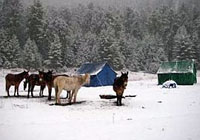Located in the central part of the country, Jigme Singye Wangchuck National Park covers 1,300sq.km and is the second largest protected area of Bhutan. The natural habitats in the park range from high permanent ice peaks to low conifer and broadleaf forests. The park was formally known as the Black Mountain National Park. The varying altitude and rainfall in the areas have created a wide diversity of climatic conditions, making it a suitable home for many species of plants, animals and birds. 1,300sq.km and is the second largest protected area of Bhutan. The natural habitats in the park range from high permanent ice peaks to low conifer and broadleaf forests. The park was formally known as the Black Mountain National Park. The varying altitude and rainfall in the areas have created a wide diversity of climatic conditions, making it a suitable home for many species of plants, animals and birds.
The park has one of the highest coverage of mature fir, pine and other types of broadleaf forests making it one of the last largest undisturbed tracks of forest in the Eastern Himalayan region. Both musk deer and Himalayan black bear can be found here. The golden langur that is endemic to Bhutan, the rare clouded leopard, the red panda and the Royal Bengal tiger are also found in the park. This National Park is an important link between the northern and southern tiger population in Bhutan. The eastern side of the park supports about 20% of Bhutan’s tiger population.
The national park is also home to 391 bird species of which seven species are among the globally threatened species. Phobjikha valley, in the buffer zone of the park, is the winter habitat of the black necked cranes. More than 260 cranes winter in Phobjikha every year.
|
